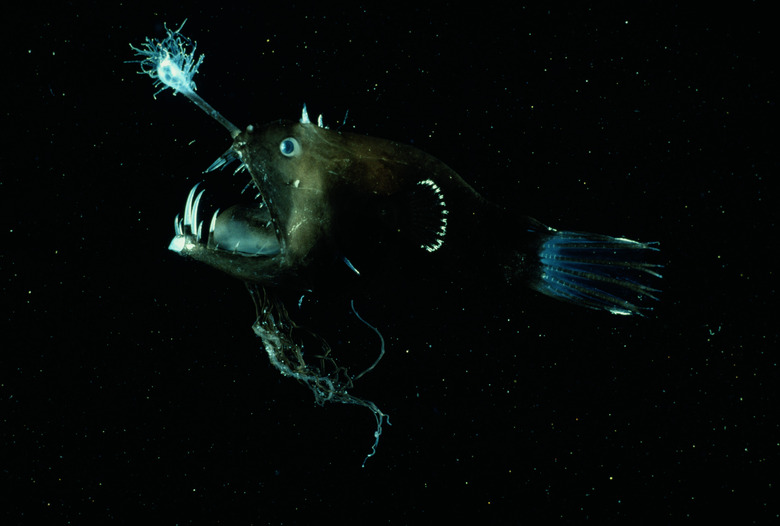List Of Animals That Emit Their Own Light
The tendency of an animal to be bioluminescent is not entirely limited to sea creatures, but the vast majority of animals that can emit their own light is in the ocean. A wide variety of fish, jellyfish and mollusks do so to lure prey or to attract a mate or simply to signal to one another. Bioluminescent fish and other creatures are only found in saltwater, not in freshwater.
Vertebrate Predatory Sea Creatures
Vertebrate Predatory Sea Creatures
Quite possibly the best-known bioluminescent fish on Earth, anglerfish use a small light at the tip of an antenna above their jaws to lure prey near enough that the fish can quickly catch its prey. Lesser well-known bioluminescent fish include the cookie cutter shark, flashlight fish, gulper eel, midshipman fishes, pinecone fishes and viper fish. Many of these creatures use a similar appendage to the anglerfish or small glowing lures near or inside their mouths. The unsuspecting animal draws closer until the predator is close enough to snap its jaws shut, capturing its prey.
Vertebrate Prey Sea Creatures
Vertebrate Prey Sea Creatures
Bioluminescence is not just limited to creatures that prey on other fish. Lanternfish and hatchetfish use bioluminescence to help avoid predators. Lanternfish, one of the most abundant creatures in the ocean, is thought to comprise between 550 million and 660 million metric tonnes of biomass, more than all the world's fishing catch combined. Prey species tend to use their bioluminescent properties to appear invisible to predators. Because predators in the ocean tend to attack from the bottom, they look for dark shapes against the lighter surface to find food. Bioluminescent fish use their light-producing bodies to help camouflage themselves from predators below them. Some unlucky predators, however, such as the viper fish, use their light-up bait at their own risk. Viper fish are a food source for some dolphins and sharks.
Invertebrate Sea Creatures
Invertebrate Sea Creatures
The crystal jellyfish is one of a large number of known species of invertebrates in the ocean that is bioluminescent. The jellyfish emits flashes of blue light from a protein that interacts with a release of calcium within the jellyfish. The number of invertebrates in the ocean that use bioluminescence far exceeds the number of vertebrates. Sea cucumbers, sea pens, corals, krill, mollusks, clams, squids and octopuses all have been known to use bioluminescence to foil predators or attract prey. Some squid and octopus species use bioluminescence rather than ink when startled. Other creatures might use bioluminescence to attract mates as well.
Insects
Insects
Although the vast majority of bioluminescent creatures on Earth are in the ocean, there are certain insects that emit their own light. Perhaps the best known are fireflies and glow worms, but certain other insects do as well. These include click beetles and railroad worms, a wide variety of subterranean worms, millipedes and centipedes. The vast majority of bioluminescent land creatures on Earth use bioluminescence to attract mates. Some others, such as the railroad worm, use as many as two different colors of illumination, which are believed to confuse and deter predators.
References
- Absolute Astronomy: Bioluminescence
- "Citizens of the Sea: Wondrous Creatures From the Census of Marine Life"; Nancy Knowlton; 2010
Cite This Article
MLA
Kress, Don. "List Of Animals That Emit Their Own Light" sciencing.com, https://www.sciencing.com/list-animals-emit-own-light-8175648/. 22 November 2019.
APA
Kress, Don. (2019, November 22). List Of Animals That Emit Their Own Light. sciencing.com. Retrieved from https://www.sciencing.com/list-animals-emit-own-light-8175648/
Chicago
Kress, Don. List Of Animals That Emit Their Own Light last modified March 24, 2022. https://www.sciencing.com/list-animals-emit-own-light-8175648/
